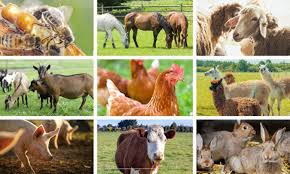Livestock produce about 30% of the agricultural gross domestic product (AGDP) in the developing world and about 40% of the global GDP.
Growing populations have raised the demand for easily cooked nutritious food, and rising incomes, which allow people to express their food preferences, have made the demand for livestock products the fastest-growing agricultural market, especially for products in which smallholders can be competitive.
Overview of Livestock Products in Agriculture
Livestock are domesticated animals raised in an agricultural setting to produce commodities such as food, fiber, and labor. Livestock are generally raised for profit.
Raising animals (animal husbandry) is a component of modern agriculture. It has been practiced in many cultures since the transition to farming from hunter-gatherer lifestyles.
Livestock production in Nigeria was dominated by nomadic pastoralism long before the advent of the British Colonial Administration. It accounts for one-third of Nigeria’s agricultural GDP, providing income, employment, food, farm energy, manure, fuel, and transport.
They are also a major source of government revenue. It has been argued that livestock, especially ruminants, are the most efficient users of uncultivated land and contribute significantly to crop production.
Efficient crop-livestock integration systems have the tendency of allowing nutrients to be recycled more effectively on the farm, thereby enhancing crop yields. In such a system, livestock can be fed on crop residues like straw, fruits, and grains, as well as other products that would have otherwise been disposed of.
Traditional livestock production is varied and complex in nature. It has evolved over centuries of adaptation under prevailing conditions of harsh climate and severe disease challenges and now represents an excellent adaptation to uncertain environmental conditions. It promotes the most efficient possible use of non-arable land and can also contribute substantially to crop production.
Read Also: Importance of a Sick Bay in a Ruminant House
Traditional Livestock Production in Nigeria
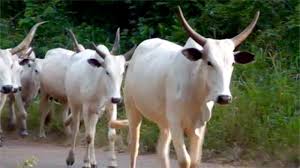
Traditional livestock production in Nigeria is varied and complex. Livestock, especially ruminants, are the most efficient users of uncultivated land and can contribute substantially to crop production.
The majority of households in both the savanna and the sub-humid zones of Africa own some livestock, be it cattle, sheep, and/or goats, in addition to poultry. These animals contribute substantially to the quality of the human diet as well as to the household economy.
Among all the livestock that make up the farm animals in Nigeria, ruminants, comprising sheep, goats, and cattle, constitute the farm animals largely reared by farm families in the country’s agricultural system.
Nigeria has a population of 34.5 million goats, 22.1 million sheep, and 13.9 million cattle. The larger proportion of these animals’ populations, however, are largely concentrated in the northern region of the country than the southern region. Specifically, about 90 percent of the country’s cattle population and 70 percent of the sheep and goat populations are concentrated in the northern region of the country.
Nigerian Livestock Population Estimates
SpeciesNumberChickens82,400,000Goats34,500,000Sheep22,100,000Cattle13,900,000Donkeys900,000Horses200,000Camels90,000Other Poultry*31,900,000Pigs3,500,000Dogs4,500,000Cats3,300,000Rabbits1,700,000Guinea Pigs500,000Giant Rats60,000
Source: Animal Genetic Resources, 2018
Prospects of the Livestock Industry in Nigeria
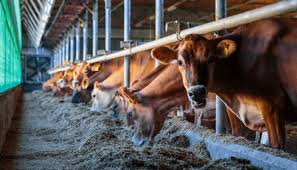
Livestock production has indeed contributed immensely to the protein needs of humankind, as it is claimed to contribute to the socioeconomic growth of the Nigerian state, particularly through its commercial farming with modern techniques.
It is expected to enhance development in a way that will guarantee food sufficiency. Over the years, animal production has been an avenue for wealth and job creation. Hundreds of thousands of youths within the Nigerian state have been engaged in one form of production or the other within this agricultural subsector.
With the growing population of the Nigerian state, animal production is also expected to grow in magnitude to meet the needs of the nation, where there will be availability of meat, milk, and eggs for human consumption as well as manure for crop production.
In the area of job creation, a good number of Nigerians have been employed in this agricultural subsector. Some are directly involved in rearing cattle, goats, and sheep. Others are in piggery, poultry, etc. A good number of them are involved in meat and animal skin production, milk production, and poultry farming, which produces both meat and eggs.
The diversification of the Nigerian economy by the Nigerian government away from oil, particularly to agriculture, has been a welcome development as many are encouraged to take to mechanized farming with a modern technology approach.
A good number of Nigerians have been taken off the streets into agriculture farming, particularly in the area of animal production, with mouth-watering grants and loans to start the business.
So, the livestock industry has been one of the fastest-growing labor employers in Nigeria. Being a major source of protein, livestock production has contributed to keeping Nigerians well and healthy, even as it has consistently contributed to the advancement of the food-for-all policy.
In animal production, plants are used for animal food, and these are the same animals whose feces are used as manure in crop production. Hence, the money spent by the Nigerian government on fertilizer is drastically reduced.
This is one among other economic importance of animal production. Most of the shoes and belts we wear are made out of animal production. So, you can now imagine the impact the livestock industry has made in the nation, economically and socially.
In spite of the contribution it has made socioeconomically to the growth of the Nigerian state, the industry, however, is challenged with some issues that are begging for attention.
Much of what we enjoy today as a result of animal production is really produced by way of traditional methods, that is, small-scale methods, as farmers are not buoyant enough in terms of finance, and the modern technology to go into commercial or large-scale production is not there.
Though some of the food taken, for example, by cattle is natural, for instance, grass, not every part of the country has this endowment. So, to go into, say, cattle production where there is none of this natural endowment, then you perhaps need a lot of money to go into the cattle business.
Many Nigerians who are into animal production lack the requisite knowledge of animal husbandry. With little grants and loans they get from the government, they do not have what it takes, the modern know-how to go about the business in a commercial dimension. They are not investing in relevant literature or a body of knowledge that can direct or instruct them on how to go about animal husbandry.
In view of the Nigerian economic reality, coupled with the growing population of this country, there is a need for sufficient food production as the population keeps increasing daily. No country can be successful unless it can feed its citizens and keep them healthy.
Animal production is promising if only the government will channel resources into this subsector and encourage commercial or large-scale production to meet the demand for food in this country.
However, the livestock industry has indeed contributed immensely to the government policy of food for all. There are some challenges facing the industry, and the way forward is for the government to pay close attention to this sector of the economy since it has reiterated its readiness to diversify the Nigerian economy.
It is glaring that agriculture will command a lot of attention in this regard. Hence, the government should encourage the youths more in agriculture business by way of inducement, by that, I mean creating attractive conditions such as training the youths on how to go about commercial production.
They should be updated with modern techniques on how to run the business. If need be, they can go for training outside the country. And I believe there is a need for technology transfer since agriculture is the only promising sector that will boost the nation’s economic status, given the current economic reality in the nation.
A new scheme should be introduced where the government will support the teeming youths with financial assistance for them to be able to run their business of animal production.
Animal husbandry contributed to well over 65 percent of the nation’s economic growth. The federal government should launch a scheme that empowers states to embark on animal production such that is peculiar to the individual state because all the states cannot produce the same animal, as climate and location differ.
Disease control must be of interest to animal producers because if one is infected, then all are in danger. The government should take this as important by making sure that all the necessary vaccines that will help control animal diseases are available to the farmers and at affordable prices.
The Economic Importance of Livestock
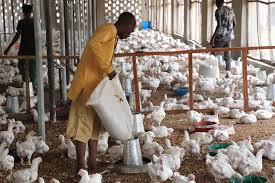
The economic importance of livestock includes the following:
1. Food Nutrition: Meat, milk, and eggs provide more than protein. They also provide essential micronutrients that are less available in plant-based foods. This makes livestock-derived foods highly valued in poor households subsisting almost wholly on high-carbohydrate starchy foods and particularly valuable for infants in their first 1,000 days of life, from conception to 2 years old.
2. Livelihood: One billion people are involved in livestock value chains globally, with more than half of these dependent on livestock for their livelihoods. Most livestock-dependent people live in developing countries and farm or herd cattle and other ruminants. Globally, livestock contribute an average of 40% to agricultural GDP, with this percentage rising fast in developing countries.
3. Health: Livestock enhance human health in developing countries by providing nourishing foods, which are the foundation of good health and help the body protect itself against and recover from disease. In addition, farm animals give people viable ways to make a living, which allow them to make better dietary and health choices and to pay for good medical care.
4. Environment: Livestock production helps make optimal use of all the planet’s biomass, exploiting its full ecological potential and supporting a circular, regenerative food production system where nothing is wasted. While livestock production inherently produces greenhouse gases, there are major opportunities to mitigate such emissions.
Read Also: Stocking Management for Ruminant Animals
Factors Militating Against Successful Animal Production in Nigeria
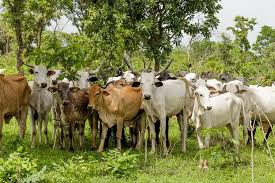
Nigeria is threatened with the problem of food insecurity and poverty because of its fast-growing population. Unfortunately, an average Nigerian still consumes far less animal protein than their counterpart in the developed world because the animal production industry is still in its infancy due to hydra-headed problems, and the per capita income is low, leading to a consumption of less than 9 grams of animal protein per capita per day as compared to over 50 grams per capita per day in North America and Europe (Boland et al., 2013).
Nigerian animal production is facing numerous challenges, with certain factors militating against successful animal production. These factors are as follows:
1. Capital: Capital is a crucial factor of production needed to set up an animal production and processing farm, and capital is needed to sustain productivity. Financial inadequacies have led to slow-growing animal industries or moribund ones or even destroyed animal production industries.
According to McKay (2012), low-income earners who dominate the animal industry are not able to cope with the demands of the industry, especially when production is not at its optimum level. To worsen matters, loan facilities are hardly available, and where they are available, there are lots of bottlenecks and constraints to accessing such loans.
2. High Cost of Animal Feeds: Nutritious animal feeds are essential for the full development and productivity of animals. Animal feeds are not readily available, and where they are, they are not easily affordable for an average farmer.
Since farmers go into animal production for profit, they need to obtain feed at a price where they do not only break even but also make a reasonable profit.
Perhaps the livestock industry of ruminants does not feel the impact as much as the poultry industry, which is mostly intensive in nature, requiring a constant supply of feeds for maximum productivity, unlike livestock, which can still be fed on pastures and forage or allowed to scavenge for food.
Due to the high cost of feeds, various research alternatives have been sought for other means of providing animal feeds to ameliorate the effects of the cost of feed, such as the use of activated sludges (Vriens et al., 1989).
3. Animal Diseases: Livestock diseases remain a veritable threat to the animal production industry. Animal products are constantly under threat by diseases that affect livestock and hence reduce productivity (MacRae et al., 2005).
Endemic animal diseases such as Helminthosis, Contagious Bovine Pleuropneumonia (CBPP), brucellosis, mastitis, peste des petits ruminants (PPR), and many others have devastating impacts upon the animal industry, leading to losses in hundreds of millions of dollars every year in developing economies like Nigeria (Bamaiyi, 2012; Bhat et al., 2012).
Brucellosis alone in sheep and goats of Borno and Yobe states of Nigeria is estimated to cost the economy USD 3.2 million annually (Brisibe et al., 1996).
4. Access to Veterinary Services, Vaccines, and Drugs: Most animal production activities are located in rural areas or remote areas inaccessible to proper veterinary services, and many that are accessible find the high cost of veterinary services prohibitive.
Hence, they resort to easily available quacks that wreak havoc on the animal industry by using expired vaccines, fake drugs, and wrong prescriptions for treating diseases. Sub-standard and all manner of low-quality drugs and vaccines are in the market now and can easily be purchased and used by practically almost everyone (Babalobi, 2005; Olugasa et al., 2013).
To have a viable and good animal production system in the country, the government should subsidize veterinary services to farmers.
5. Level of Education of Farmers: Farmers generally have a low level of education or are even illiterates, making it difficult for them to employ modern animal production techniques where traditional techniques have failed or yielded less profit.
Adebayo and Adeola (2005) opined that farmers with higher educational levels achieved higher productivity in their farm enterprises. Therefore, farms managed by educated entrepreneurs will perform better than those managed by illiterates.
6. The Role of the Government: Government policies are expected to drive the development and sustainable availability of animal products. Unfortunately, failed policies limit the progress of the animal industry.
Banning the importation of goods not readily available in the country in an attempt to help home-grown industries but without providing viable alternatives leads to shortages and skyrocketing high prices of animal products.
7. Urbanization: Rapid urbanization in many developing countries like Nigeria comes at a high price to animal productivity due to the neglect of animal farming as a result of mass rural-urban drift for better standards of living, and yet increased demand for animal products is the order of the day (Devendra, 2007).
According to Van der Zijpp (1999), urbanization is usually associated with higher income, which increases the purchasing power of individuals, leading to higher demands for better quality food, which entails a good amount of animal protein in the food, unlike the normal rural food, which has less animal protein and more carbohydrates and fats.
Urbanization also leads to constraints of space due to overcrowding arising from population explosion in the cities (Alirol et al., 2011; Lancet, 2011). This implies that there will be less opportunity for animal production as emphasis shifts to rapid industrialization.
Nigerian cities like Lagos consume a lot of meat mainly brought from some northern parts of the country like Borno state, which accounts for about a quarter of all ruminant livestock population in the country.
8. Market and Storage Facilities: The sustainability of animal products is dependent on the market for animal products. The reality is that the animal production market is poorly organized, and often farmers lose instead of making a profit because most animal products are perishable goods that expire within a short period of time.
China, according to Zhou et al. (2012), has over the years rapidly developed its animal production industry, leading to a meat industry revolution with international processing and storage facilities good enough for local consumption of a large population and export. This is a contrast to the situation in Nigeria, with the largest population in Africa and significant animal population, but the market and storage facilities are still mostly primitive.
To encourage maximum animal productivity, there should be provision for storage of animal products in deep freezers and other storage facilities that are now being used with technological advancement. Employing modern methods of meat preservation will help Nigeria grow its animal production to be able to take part in international trade and better the economy of the nation.
9. Inadequate Extension Services: Extension services are crucial in promoting good agricultural and farming practices among our animal industry stakeholders. The livestock industry can produce more than it is doing currently if the farmers are well enlightened on certain aspects of production.
A good number of Nigerian universities and other institutions offer courses on agricultural extension services, but the number of graduates each year that end up in the actual profession of agricultural extension are still grossly inadequate compared with the population involved in farming and the locations of those they are supposed to service.
Extension workers provide technical advice to farmers on techniques for maximum productivity and advise on market-related matters with the ultimate aim of ensuring the farmers succeed in their chosen vocation and contribute meaningfully to the economy of the nation (Davis, 2008).
Well-trained extension service workers could be deployed to help train farmers in remote locations and get answers to their questions. This training could be strategically positioned at farmers who command a lot of market and followership, who will, in turn, influence other farmers.
Unfortunately, in Nigeria, the number of qualified agricultural extension workers is grossly inadequate to make a meaningful impact on the economy of a nation with a large population like Nigeria. In some remote areas, such extension services are lacking completely, and farmers are left to use their traditional knowledge to improve animal productivity.
One of the greatest challenges of extension services in Nigeria, in spite of the intervention of a World Bank-assisted project, is the ability to secure the commitment of the government and mobilize local funds to sustain the service (Omotayo et al., 2001).
10. Inadequate Manpower: Skilled labor in the animal production industry in Nigeria, for example, in some quarters, one man does the work of many people, leading to inefficiency in productivity. This is a point for major concern because of the potentials of a nation of over 170 million people (Population, 2012).
If more people are encouraged to go into animal production like in China (Zhou et al., 2012), Nigeria will have adequate manpower involved in animal production. There is inadequate labor supply in the country, and many times farmers have to hire temporary workers or forfeit it at the detriment of their farms due to costs (Ude and Salau, 1987).
It is gratifying to note that women, like their men counterparts, are actively involved in animal production in Nigeria (Adekanye, 1984; Porter, 1995). But in spite of all these, the manpower is still inadequate for the industry and for sustainable animal production.
11. Transportation: Transportation is critical to the success of the animal industry. According to Gujba et al. (2013), the movement of animal products from production to consumption points requires good transport networks, which are either non-existent or in very bad shape in Nigeria.
Many of the methods used in Nigeria for transporting ruminants from the north to the south of the country go against standard animal welfare procedures for the safety and welfare of the animals.
The animals are under undue stress as they are overcrowded in trailers for mass transport, making them sustain traumatic injuries and stress that affect their health and productivity. There is a need to improve on these transport systems for maximum animal production because good transport is essential for food security.
12. Inadequate Basic Infrastructure: Generally, there is a lack of proper mechanized animal farming using modern infrastructure such as improved milking machines that could reduce the incidence of diseases like mastitis, good animal houses to help the productivity of the animals by focusing on intensive farming instead of allowing small ruminants, for example, to roam about scavenging for food, and the large ruminants invading crop farms in the community and destroying harvests meant for human consumption an issue which has often been a source of communal conflicts.
The perennial problem of electricity supply in Nigeria is a major setback for the livestock industry. It means meat has to be prepared for consumption immediately after slaughter, or additional costs of utilizing generating plants to store the meat will be incurred. Water supply is also inadequate, even though it is very essential to have water always for maximum animal productivity.
13. Climatic and Environmental Factors: Certain climatic factors are natural, and some are man-made due to human activities, but they affect animal production. Desert encroachment is a major environmental problem in the northern part of Nigeria.
Deforestation as a result of human activities diminished the potential animal’s role in providing renewable energy. Desert encroaches in the northern part of the country; hence, nomadic Fulani are forced to keep migrating southwards in search of pasture for their cattle and expose their animals to diseases of the rainforest such as Trypanosomosis, which will affect the productivity of the animals. Some natural disasters like floods affect agricultural produce and animal production.
14. Attitude to Animal Production: People’s attitude to animal husbandry and production is very poor. Some young people in Nigeria think animal production is only for the elderly or sometimes retired government staff, but youths are known to do very well in animal production when they diligently go into it.
Multi-functionality of Livestock
Farm animals continue to play several central roles in the livelihoods of people in developing countries, ranging from providing households with high-quality foods, good nutrition, and regular incomes to providing laborers with jobs, community members with social status, and farmers and herders with ways to sustain food production.
Food and nutrition: In order to increase livestock’s contribution to the livelihoods of developing communities, an improved understanding of livestock’s multiple and complex roles is required. The contribution of food from animal origin to the nutritional status of the world population is well documented (Ndlovu, 2010).
Beyond the important role that livestock play in the provision of food and nutrition in people’s diets, they also have important social functions.
They raise the social status of owners and contribute to gender balance by affording women and children the opportunity to own livestock, especially small stock (Waters-Bayer and Letty, 2010). In marginal areas with harsh environments, livestock provide a means of reducing the risks associated with crop failure and a diversification strategy for resource-poor small-scale farmers and their communities (Vandamme et al., 2010).
The livestock industry is a cornerstone of Nigeria’s agricultural economy, contributing significantly to food security, employment, and socioeconomic development. However, addressing the challenges facing the sector is crucial for its growth and sustainability.
With government support, modern technology, and improved infrastructure, the livestock industry can meet the nation’s growing food demands and contribute even more to Nigeria’s economic development.
Do you have any questions, suggestions, or contributions? If so, please feel free to use the comment box below to share your thoughts. We also encourage you to kindly share this information with others who might benefit from it. Since we can’t reach everyone at once, we truly appreciate your help in spreading the word. Thank you so much for your support and for sharing!
Read Also: The Impact of Inefficient Waste Management on Oceans
Frequently Asked Questions
We will update this section soon.

